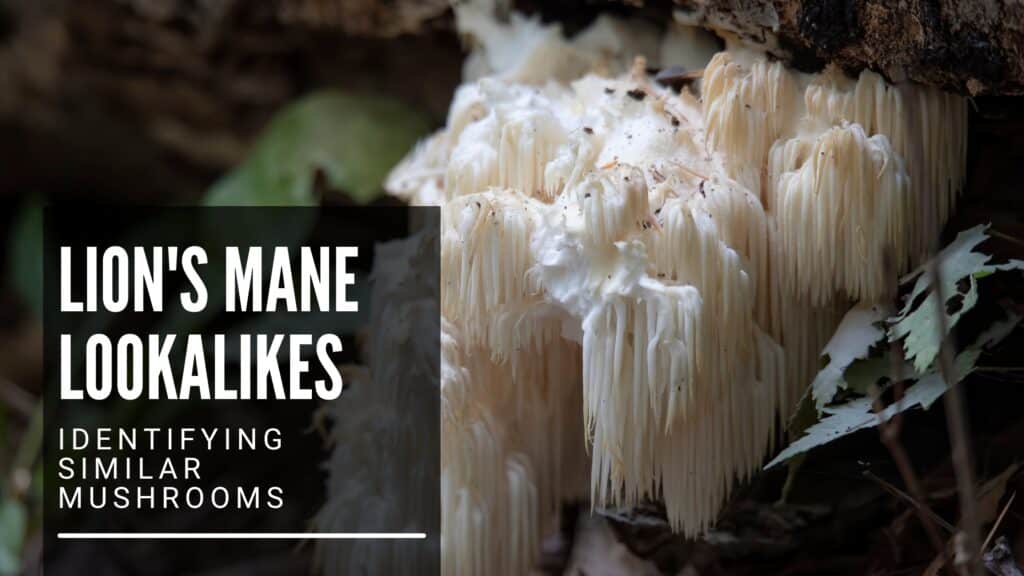Lion’s Mane (Hericium erinaceus) is a fascinating and highly prized mushroom known for its potential health benefits. However, several other mushrooms can easily be mistaken for it. This can be a real issue for foragers and anyone looking to harness its medicinal properties. In this article, we’ll explore how to accurately identify Lion’s Mane and distinguish it from its lookalikes. By the end, you’ll know exactly what to look for to ensure you’re picking the right mushroom.
Quick Summary
- Lion’s Mane (Hericium erinaceus): Distinctive long spines, white to off-white color.
- Common Lookalikes: Bear’s Head (Hericium americanum), Coral Tooth (Hericium coralloides), and others.
- Identification Tips: Check for spine length, growth pattern, and habitat.
- Health Benefits of Lion’s Mane: Supports cognitive function, nerve health, and overall well-being.
Understanding Lion’s Mane Mushroom
What is Lion’s Mane?
Lion’s Mane (Hericium erinaceus) is a medicinal mushroom renowned for its unique appearance and health benefits. It belongs to the tooth fungus group and is easily recognizable due to its long, cascading spines that resemble a lion’s mane. This mushroom has garnered attention not only for its striking look but also for its potential therapeutic properties. Traditionally used in Asian cuisine and medicine, Lion’s Mane has been linked to various health benefits, particularly in supporting cognitive function and nerve health.
Key Characteristics of Lion’s Mane
Appearance
Lion’s Mane mushrooms feature long, white spines that hang down from a central mass. These spines can grow up to 1-3 centimeters in length, giving the mushroom its distinctive icicle-like appearance. As the mushroom matures, the spines may develop a slightly yellowish tint. Unlike other fungi, Lion’s Mane does not have a cap or stem, which makes it quite unique among mushrooms.
Habitat
Lion’s Mane typically grows on hardwood trees, with a preference for beech trees. It can also be found on oak, maple, and sycamore trees. This mushroom is saprotrophic, meaning it feeds on decaying wood, playing a crucial role in the ecosystem by breaking down dead trees and recycling nutrients. It is most commonly found in temperate forests, where it thrives in the cool, moist environment provided by dense tree cover.
Season
The prime season for Lion’s Mane is from late summer to fall. During this period, the conditions are ideal for its growth, with the right combination of temperature and humidity. Foragers often look for it in these months, as it is easier to find and identify when the fruiting bodies are fully developed.
Health Benefits of Lion’s Mane
Lion’s Mane is not just a culinary delight but also a powerhouse of potential health benefits. Studies have shown that it contains compounds that may promote cognitive health by enhancing memory and concentration. One of the most notable components of Lion’s Mane is its ability to stimulate the production of nerve growth factor (NGF), which is essential for the growth and maintenance of neurons. This property makes it a promising natural remedy for neurodegenerative diseases such as Alzheimer’s.
In addition to cognitive support, Lion’s Mane is rich in antioxidants and possesses anti-inflammatory properties. These characteristics contribute to its overall health benefits, helping to protect the body from oxidative stress and inflammation, which are linked to various chronic diseases. Moreover, Lion’s Mane has been used traditionally to support digestive health, boost the immune system, and improve overall well-being.
Common Lookalikes
Several mushrooms resemble Lion’s Mane (Hericium erinaceus), which can lead to confusion during identification. Understanding these lookalikes and their distinguishing features is crucial for accurate identification.
Bear’s Head Tooth (Hericium americanum)

Appearance
Bear’s Head Tooth mushroom is one of the closest lookalikes to Lion’s Mane. It shares a similar structure with long, white spines, but there are key differences. The spines of Bear’s Head Tooth are generally longer and more densely packed than those of Lion’s Mane. The mushroom forms a more branched structure, often appearing as multiple clusters rather than a single mass. This branching habit can help distinguish it from Lion’s Mane, which tends to grow as a singular, unbranched formation.
Habitat
Bear’s Head Tooth is commonly found on hardwood trees, much like Lion’s Mane. It prefers deciduous forests in North America and often grows on oak, beech, and maple trees. It can be found at various heights on the tree, from the base to higher up on the trunk, thriving in similar environmental conditions to those of Lion’s Mane.
Distinguishing Features
The primary distinguishing features of Bear’s Head Tooth include its more branched structure and the length and density of its spines. While Lion’s Mane has spines that hang down like icicles, Bear’s Head Tooth has a more bushy appearance with spines that are slightly longer and more densely packed.
Coral Tooth (Hericium coralloides)

Appearance
Coral Tooth mushroom has a distinctive coral-like appearance, with multiple branches covered in short, white spines. These spines are significantly shorter than those of Lion’s Mane, usually less than 1 cm in length. The overall structure of Coral Tooth is more intricate and delicate, resembling underwater coral formations rather than the icicle-like structure of Lion’s Mane.
Habitat
Coral Tooth mushrooms are typically found on decaying hardwood logs. They thrive in temperate forests, often appearing on fallen or dead wood, which provides the necessary nutrients for their growth. This habitat preference is similar to that of Lion’s Mane, although Coral Tooth tends to be more prolific on dead wood rather than living trees.
Distinguishing Features
The key features that set Coral Tooth apart from Lion’s Mane include its shorter spines and highly branched, coral-like structure. Unlike Lion’s Mane, which grows as a single mass, Coral Tooth forms intricate, multi-branched clusters. This complex structure, along with the shorter spine length, makes it relatively easy to differentiate from Lion’s Mane upon close inspection.
Other Lookalikes
Hericium abietis
Hericium abietis, commonly known as the Western Spotted Coral, is another lookalike found primarily in North America. It grows predominantly on conifer wood, such as fir and spruce trees. This habitat preference is a key distinguishing factor, as Lion’s Mane typically grows on hardwoods. Hericium abietis has a branched structure with spines that can vary in length, similar to those of Bear’s Head Tooth.
Hericium alpestre
Hericium alpestre is found in Europe, primarily growing on dead wood of coniferous trees. This species is less commonly encountered than its North American counterparts but can still cause confusion. It has a similar branched structure and spine arrangement to other Hericium species, with the main distinguishing feature being its preference for coniferous substrates.
Tips for Accurate Identification
Spine Length and Structure
Accurate identification of Lion’s Mane and its lookalikes can often hinge on the length and structure of the spines. Lion’s Mane has long, icicle-like spines that hang down from a central mass. In contrast, lookalikes such as Bear’s Head Tooth and Coral Tooth have varying spine lengths and more branched structures.
Growth Pattern
Lion’s Mane grows as a single, unbranched mass, which is a key identifying feature. Lookalikes like Bear’s Head Tooth and Coral Tooth tend to have branched, coral-like growth patterns. This difference in growth habit is one of the easiest ways to distinguish Lion’s Mane from its lookalikes.
Habitat and Substrate
Understanding the preferred habitats and substrates of these mushrooms can also aid in accurate identification. Lion’s Mane typically grows on hardwoods, especially beech trees. Lookalikes such as Hericium abietis and Hericium alpestre prefer coniferous trees. Noting the type of tree and the condition of the wood (living vs. decaying) can provide important clues for proper identification.
Why Accurate Identification Matters
Accurate identification of Lion’s Mane mushroom is crucial for several reasons. Misidentifying this mushroom can lead to health risks and missed benefits. Understanding the importance of proper identification can help foragers and consumers make informed decisions.
Health Benefits of Lion’s Mane
Cognitive Support
Lion’s Mane has garnered attention for its potential to support cognitive function. Studies suggest that compounds found in Lion’s Mane, such as hericenones and erinacines, stimulate the production of nerve growth factor (NGF). NGF is essential for the growth, maintenance, and survival of neurons. By promoting NGF production, Lion’s Mane may enhance memory, focus, and overall cognitive health. This makes it a valuable natural supplement for individuals seeking to improve their mental clarity and prevent cognitive decline.
Nerve Health
The neuroprotective properties of Lion’s Mane extend beyond cognitive enhancement. Research has shown that Lion’s Mane can aid in the repair and regeneration of nerve cells. This makes it a promising candidate for treating neurological conditions such as peripheral neuropathy, a condition often associated with diabetes and chemotherapy. The mushroom’s ability to support nerve health can help alleviate symptoms such as pain, tingling, and numbness, improving the quality of life for affected individuals.
Overall Well-being
In addition to its cognitive and nerve health benefits, Lion’s Mane is rich in antioxidants and possesses anti-inflammatory properties. Antioxidants help protect the body from oxidative stress, which is linked to chronic diseases such as cancer and heart disease. The anti-inflammatory effects of Lion’s Mane can reduce inflammation throughout the body, further supporting overall health and well-being. Regular consumption of Lion’s Mane can contribute to a balanced immune system, better digestive health, and improved general wellness.
Risks of Misidentification
Potential Toxicity
One of the primary risks associated with misidentifying Lion’s Mane is the potential toxicity of lookalike species. While many of Lion’s Mane’s lookalikes are not toxic, there are some species that can cause adverse reactions if consumed. For example, some inedible or poisonous fungi may resemble Lion’s Mane to the untrained eye. Consuming these lookalikes can lead to gastrointestinal distress, allergic reactions, or more severe health issues. Ensuring accurate identification is essential to avoid the dangers of toxic mushrooms.
Missed Benefits
Another significant risk of misidentification is missing out on the unique health benefits provided by true Lion’s Mane. While some lookalikes, such as Bear’s Head Tooth and Coral Tooth, may also have medicinal properties, they do not offer the same spectrum of benefits as Lion’s Mane. Misidentifying and consuming these lookalikes instead of true Lion’s Mane means losing out on the specific compounds that support cognitive function, nerve health, and overall well-being. Accurate identification ensures that individuals can fully reap the benefits of Lion’s Mane.
Conclusion
Accurately identifying Lion’s Mane mushroom is essential for anyone interested in its health benefits. Knowing how to distinguish it from its lookalikes ensures you can enjoy all the advantages it offers without the risks associated with misidentification. By focusing on the key differences—such as spine length, growth pattern, and habitat—you can confidently forage for Lion’s Mane.
This remarkable mushroom supports cognitive function, nerve health, and overall well-being, making it a valuable addition to your diet. However, if you consume a lookalike by mistake, you could miss out on these benefits or even encounter harmful effects.
To make the most of Lion’s Mane, take the time to study its characteristics and those of its lookalikes. Use reliable sources and identification guides to aid your foraging. By doing so, you’ll not only stay safe but also ensure you’re getting the full range of health benefits that only true Lion’s Mane can provide.
References
- Docherty, Sarah, et al. “The Acute and Chronic Effects of Lion’s Mane Mushroom Supplementation on Cognitive Function, Stress and Mood in Young Adults: A Double-Blind, Parallel Groups, Pilot Study.” Nutrients, vol. 15, no. 22, 20 Nov. 2023, pp. 4842–4842, https://doi.org/10.3390/nu15224842.
- Kushairi, Naufal, et al. “Lion’s Mane Mushroom, Hericium Erinaceus (Bull.: Fr.) Pers. Suppresses H2O2-Induced Oxidative Damage and LPS-Induced Inflammation in HT22 Hippocampal Neurons and BV2 Microglia.” Antioxidants, vol. 8, no. 8, 1 Aug. 2019, p. 261, https://doi.org/10.3390/antiox8080261.
- Lai, Puei-Lene, et al. “Neurotrophic Properties of the Lion’s Mane Medicinal Mushroom, Hericium Erinaceus (Higher Basidiomycetes) from Malaysia.” International Journal of Medicinal Mushrooms, vol. 15, no. 6, 2013, pp. 539–554, https://doi.org/10.1615/intjmedmushr.v15.i6.30.



